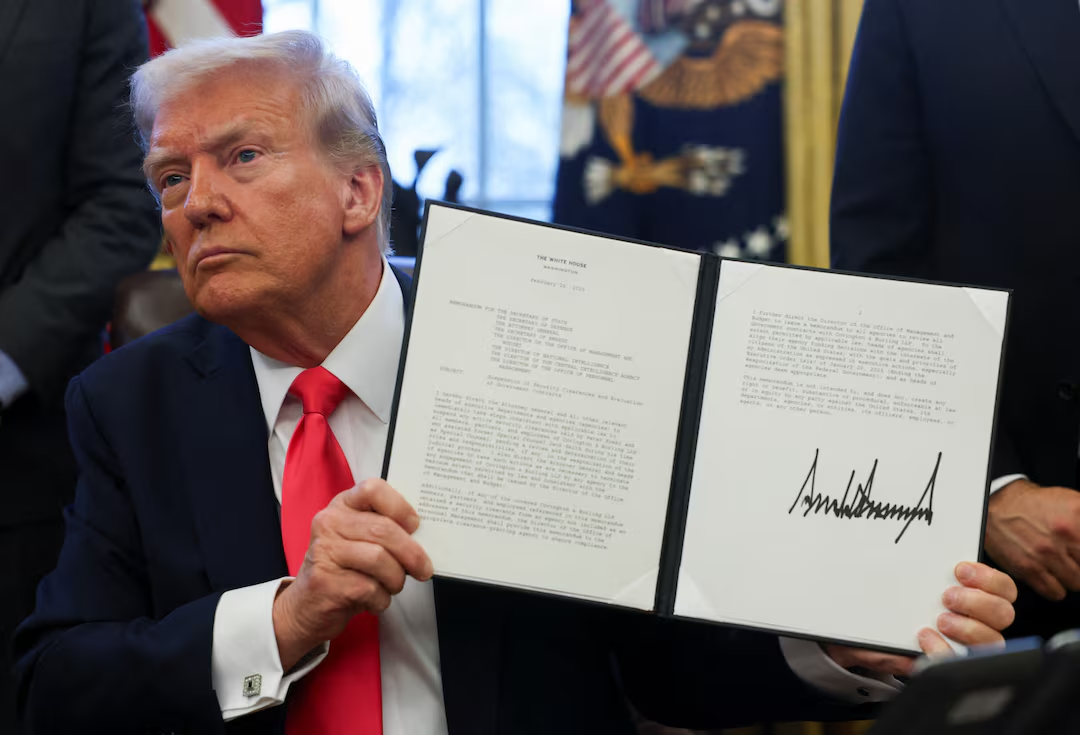-
Here is what’s going on
-
Trump’s 2025 term has already seen a large number of executive orders: as of mid-2025, he had signed well over 150 orders. Ballotpedia+2The White House+2
-
Many of these orders seek to reverse or reshape policies from previous administrations (especially Biden’s), particularly in areas like technology, immigration, regulation, and national security. The White House+4The White House+4The Guardian+4
-
Some of the newer ones address emerging issues like artificial intelligence, cybersecurity, and trade threats.
Below are a few of the most notable recent executive orders (or groups of orders), what they do, and the debates surrounding them.
Select Recent Executive Orders
“Unlocking Cures for Pediatric Cancer with AI” (Sept 30, 2025)
-
On September 30, 2025, Trump signed an executive order designed to expand the use of artificial intelligence in childhood cancer research, by allocating an additional US$50 million in research grants. Reuters+1
-
The order supplements the existing Childhood Cancer Data Initiative (CCDI). The National Institutes of Health (NIH) will match the funding. Reuters
-
Significance & implications:
• It signals a push to harness AI in medicine, especially for rare diseases where data is limited.
• It may also reflect broader ambitions to assert the U.S. as a leader in AI-enabled science.
• Critics might point to budgetary tradeoffs (e.g. cuts elsewhere) or concerns about data privacy, equity in access, and how AI models are validated.
“Assuring the Security of the State of Qatar” / Mutual Defense Commitment (Approx Sept 29, 2025)
-
Around September 29, 2025, Trump signed an executive order pledging to defend Qatar if it were attacked, declaring that any such attack would be seen as a threat to U.S. peace and security. AP News+2Politico+2
-
This is an unusual move because it resembles a mutual defense guarantee of the kind normally embedded in treaties — which typically require Senate ratification. Politico
-
Debate & scrutiny: Critics question the legal authority and constitutionality of using an executive order to commit the U.S. to military action without congressional approval. Also, it’s a sharp shift given Trump’s prior “America First” foreign policy rhetoric.
Cyber / Digital Identity Order (Mid-2025)
-
Trump signed a cybersecurity-oriented executive order that, among other things:
• Rolls back digital identity mandates from previous administrations. CyberScoop+1
• Refocuses federal AI cybersecurity efforts on identifying vulnerabilities rather than censorship. CyberScoop
• Calls for updated guidance on secure software development and cryptography, including post-quantum cryptography. CyberScoop -
This order also rescinds or modifies portions of prior executive orders from Biden and Obama in the digital/identity space. CyberScoop+1
-
Implications:
• It signals a shift in federal cybersecurity posture, emphasizing resilience and technical security over digital government / identity infrastructure.
• Some cybersecurity advocates raised concerns that removing more structured mandates might weaken uniform standards or oversight.
Drones, Supersonics & Aviation Innovation (June 2025)
-
In June 2025, Trump signed three executive orders aimed at accelerating development in cutting-edge aviation: domestic drone manufacturing, securing U.S. airspace, and promoting supersonic flight. The White House
-
The orders aim to reduce regulatory barriers, improve supply chains, and reestablish U.S. leadership in advanced aerospace. The White House+1
-
This cluster fits into a broader push by the administration to prioritize technological and industrial competitiveness.
Ending Crime & Disorder on America’s Streets (July 24, 2025)
-
This executive order, titled “ENDING CRIME AND DISORDER ON AMERICA’S STREETS,” sets forth a range of measures. The White House
-
Among its provisions: assessing federal grants to see whether priority can go to states/municipalities that comply with certain criteria regarding vagrancy and public order. The White House
-
It is part of Trump’s domestic law-and-order agenda, though much will depend on how agencies interpret and implement the guidelines, and on legal constraints (e.g. local autonomy, civil rights).
Immigration & Sanctuary Policy: “Protecting the American People Against Invasion” (Jan 20, 2025)
-
One of the early orders of Trump’s second term, EO 14159, is titled “Protecting the American People Against Invasion.” Wikipedia
-
Key features: expanding expedited removal (i.e. deportations without hearings in some circumstances), denying federal funding to sanctuary jurisdictions, and increasing penalties for undocumented immigrants who do not register. Wikipedia
-
This order has already faced legal challenge. In April 2025, a federal judge blocked implementation of parts of it—specifically the clause denying funds to sanctuary cities. Wikipedia
H-1B Visa Restrictions / $100,000 Fee (Sept 2025)
-
Trump issued a proclamation (or order) to restrict the entry of new H-1B nonimmigrant workers unless their visa petitions are accompanied by a US$100,000 payment. The White House+2CBS News+2
-
While it’s phrased as a proclamation, it functions as an executive action impacting immigration and labor. The White House+2CBS News+2
-
Potential effects and controversies:
• It raises the cost barrier for hiring foreign skilled workers, potentially reducing reliance on H-1B visas.
• Tech firms and industry critics warn of shortages of specialized talent.
• There is legal ambiguity over whether such a high fee constitutes an unlawful barrier or violates due process or trade/immigration statutes.
Legal, Political, and Constitutional Issues
-
Scope of executive power
Many of these orders push the boundary of what can be done unilaterally, especially when dealing with military commitments (e.g. Qatar defense), foreign policy, or restrictions on immigration. The constitution vests foreign affairs and the power to declare war in Congress, so the use of executive orders in these domains can spark legal challenges. -
Statutory authority & consistency with existing laws
Some orders (e.g. tariffs on Indian imports of Russian oil) rely on authorities like the International Emergency Economic Powers Act (IEEPA) or Trade Acts. Whether they exceed or conflict with existing statutes may be contested. The White House -
Judicial review & injunctions
As seen with EO 14159 (sanctuary city funding), courts are already intervening. Some orders may be temporarily or permanently blocked by the judiciary on grounds such as violation of separation of powers, due process, or statute. -
Implementation & administrative capacity
Executive orders often require follow-through by agencies via rulemaking or internal guidance. The real impact depends on how strongly agencies push them, whether they have resources, and how much resistance or challenge they face. -
Political backlash & public reception
Many of these orders tap into polarized issues: immigration, tech regulation, foreign policy. They can mobilize both support and opposition in Congress, the public, and interest groups.


Leave a Reply